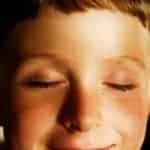Negativity Bias and Mindfulness
It means that our brain and body constantly scan the environment for threats.  If we detect a threat, we manage it as it activates our stress response (fight/flight/freeze) – which is designed to keep us alive.
If we detect a threat, we manage it as it activates our stress response (fight/flight/freeze) – which is designed to keep us alive.
What it means is that we are hardwired (neurologically speaking) to seek out the negative in our life experiences more easily than the positive ones.
As Rick Hanson, Ph.D., a neuropsychologist and author of “Buddha’s Brain: The Practical Neuroscience of Happiness, Love, and Wisdom” argues that our brains are like Velcro for negative experiences, and Teflon for positive ones.
I found this fascinating.
Does it mean that we are at the mercy of this and can’t change anything. No, I don’t believe so.
Our brain is doing it’s job and part of it called the amygdala (which I talk about in my 2nd book – Connected Kids) is designed to set off an alarm if a threat is detected.
However if the amygdala is overstimulated (lots of stressful situations), we can use meditation and mindful activities to self soothe. This helps reactive brain to step down from active duty. In other words, to help our bodies and our minds return to a calmer state.
Why is this important for your kids?
What if, as parents and carers, we were thinking (as we do) that we are responsible for any threats that may harm our children. Surely this would mean that we need to be on full alert all the time to ensure they are safe. So now, our amygdala and it’s brain connections are scouring the environment for threats to you and to your kids.
I believe this takes us into a constant state of stress and entrenches us in our negativity bias.
This is why when I’m teaching people to teach kids meditation, I encourage them to practise meditation for their own health and wellbeing. This is a crucial step. We can’t support another person if we can’t support ourselves.
Self Support – with mindfulness
If we are ungrounded, on high alert through stress and our kid starts having a meltdown in a public place, we’ll react to this.
If we are grounded, able to remain calm and alert – we’ll respond to this.
There is a difference.
I walked around the supermarket the other day and I could see a small boy of about 2 or 3 years old having a meltdown. His father was choosing to ignore him – carrying on with the shop and not giving him any attention. This seemed to be like throwing fuel on the fire.
This little boy wasn’t trying to control or manipulate his father (the cognitive functions of his brain aren’t able to do this at this age), but perhaps the dad was…
- embarassed
- ashamed
- stressed
- annoyed
- or experiencing another strong emotion
…and his way of dealing with it was to ignore the situation; very similar to one of our stress responses where we ‘freeze’ – to avoid dealing with the issue hoping it will go away.
If that father had practised meditation on a regular basis, he would be able to check in with his breath and his body to notice that he was beginning to react.
He could use a meditation technique right there in the supermarket (no sitting down cross legged or strange posture – just standing) but enabling him to stay grounded even with this huge response from his child.
And I know that in this calmer state he would have been able to ‘tune in’ to his son and respond in a way that was loving, firm and fair.
If we want children to learn to be calmer, we have to practise it too. If we want kids to learn how to process difficult moments and emotions with more peaceful awareness, we have to teach them how to check in, and then what to do when they notice triggers.
Is your glass half full or half empty?
We have that old saying ‘is your glass half full or is it half empty’? Through meditation practice (and I speak from personal experience) it is possible to shift our attitude from a ‘glass half empty’ to glass half full’ thought pattern through mindfulness and meditation. The first step is noticing which half of the glass you are focusing on.
So… back to parenting. If we see our kids behaving in a way we don’t like, are we reacting to this because our ‘glass is half empty’ – eg our minds are set in the negativity bias? “He’s such a monster, always playing up every time I come into the supermarket… why does he want to make such an exhibition… he knows how to press my buttons”.
Or is the glass half full …”he was fine this morning but since we’ve come into the supermarket something has upset him. Maybe as a 3 year old he feels a bit overwhelmed with all these people, the noise, the lights and being in this strange place. He just wants to play with his toys and this is boring for him”.
When we practise meditation for our own well being, we shift our attention away from the negativity bias of glass half empty and we start to ‘see’ that our children are doing the best that they can in every moment. They are processing information, physiologically changing at a super speed and having emotions they don’t have words for. It’s all new, it’s all exciting and sometimes it is a bit overwhelming.
So before you go to teach your kids meditation, set up our own
regular practise. If you do, you’ll see the best and the beauty of your kids in each and every moment.
Namaste
- Learn how to teach kids meditation (online course)
- Read more about the amygdala in our Connected Kids book>>
- Learn more about the amygdala on our course >>>
- Connected kids tutors worldwide >>>




I’m reading your Connected Kids book and I have to say, it is remarkable. I have two special needs children, and work as an art therapist at a children’s hospital. The negativity bias is such a compelling theory and so true. My son has behavior issues as a result of attachment and severe trauma (he is adopted) and I used to immediately label him ( in my head ) as difficult, manipulative, Nd rotten. It’s taken so long to realize that he is struggling and I have to remain calm and grounded so he can learn it for himself. My daughter has autism, and is highly intelligent and cannot filter out stress, anxiety and stimulus. I’ve had to learn to take a deep breath and remain calm when she is dysregulated so she won’t sense my stress and become further anxious. I’ve used many of the meditation, guided imagery directives from your book ! Your work is accessible, backed by research and can be applied to both my personal and professional lives. Thank you sooooo much for all you do.
Hi Heather – really appreciate your post. Which country are you in?